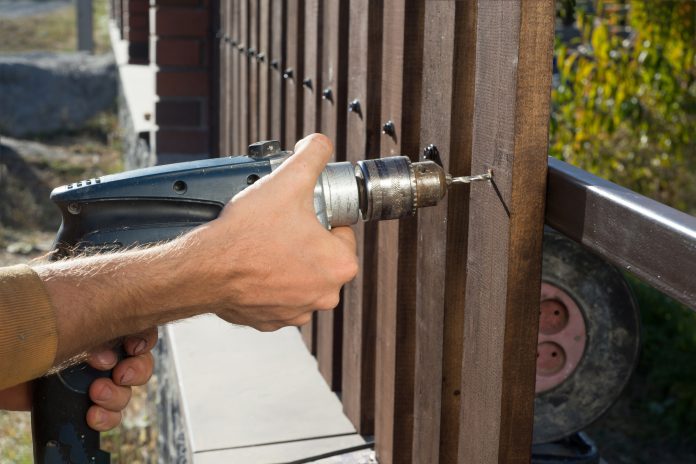
So you’re considering constructing your own fence. It’s a fine task for the DIY enthusiast, and it doesn’t take much in the way of specific tools.
You could call in a professional to put up a fence. But if you’re on a budget, it could be worth your time to install your own fence.
That being said, it may take a long time, depending on your carpentry skills. However, there may be professional fence builders out there that will offer you value for the money and high-quality options if in doubt.
Let’s delve a little deeper into this matter and determine how much it will cost to try your hand at fence building at home.
Fence Building Factors to Consider
There are a few factors to consider to answer the question, “how much to install a fence?” First, the type of materials you wish to use, along with length, height, and style, can affect the total cost.
If we had to estimate ballpark figures, a fence for a typical American home might cost anywhere between $1,500 to $4000 or more. But it’s up to you to set a realistic budget and compare material costs yourself. For example, you may have a friend or a source that can supply you with cheap or even free materials for your project.
So now, let’s look at fence materials and styles. We’ll skip out on the height and length factors since it’s pretty apparent the longer and higher your fence, the more it will cost.
Fence Materials
Whether you pay for installation or build your own fence, you have a lot of options. But, the materials you choose will make a considerable price difference overall.
As well, if you’re not a seasoned DIY enthusiast, you might not want to risk damaging high-quality and expensive materials. Confidence and experience are essential when working with such materials.
Panels Or Pickets
Purchasing pickets and timber rather than pre-made panels save money. More customization is possible, and you may even spread the pickets wider apart to save money on materials.
However, choosing panels, in the long run, might save you a lot of time. And the good thing about panels is that you already know they’re going to look professional.
Spruce
Spruce fences are common and inexpensive, although they aren’t as long-lasting as other wood types. Pickets can cost just $2 per unit, while panels cost about $40 to $50.
Professionals may advise you to choose a cheaper wood for your fence posts, such as spruce. Spruce is an excellent way to get into building if you’re considering this as DIY practice. You won’t have to worry about wasting pricey supplies.
Redwood
As beautiful as this wood is, it’s pretty pricey. The cost of redwood varies based on your location and the time of year.
Since the red color fades with age, you’ll need to treat this wood to keep it looking beautiful for years. Although, if you’re willing to put in the effort, it’s worth it!
White and Red Cedar
Red cedar is a durable wood and is ideal for decking or various outdoor applications. The natural hue of red cedar is appealing, but it is more costly than other wood alternatives.
White cedar costs less than red cedar. But, it does not last as long as red cedar.
Other Common Fence Materials
We’ve run through some of the higher-quality wood materials. Here are some other options to consider too:
- Vinyl fencing
- Pressure-treated wood fencing
- Chainlink fencing
Vinyl fencing is an excellent option for less experienced DIY enthusiasts. Pressure-treated wood lasts a long time and is an economical option. Chainlink fencing is simple to install, but you still need to put in posts.
Fence Style
The first style of fence we’ll cover is a privacy fence. Since the idea of a privacy fence is to obscure the view of your yard, you’ll need loads of wood.
They’re usually six-foot pickets with optional lattice panels on top. So, material costs may be high when installing your own privacy fence.
A classic picket fence requires fewer materials and may be anywhere from four to six feet tall. Installing it will still take some skill. However, the beauty of making your own picket fence is that you may space out the pickets wherever you like.
A split rail fence is simple and has a rustic appearance. Two to four horizontal beams link it to the rest of the structure.
People tend to use them to keep animals on their land, but they may also serve as an attractive boundary. This is a more manageable fence to construct for a handy individual.
Finally, custom fencing is where making your own fence may pay off if you’re a skilled woodworker. Funky patterns or big scalloped fences will command a premium from professionals.
However, if you don’t know what you’re doing and want a unique-looking, bespoke fence, it might wind up costing you a lot of money. You might even have to start all over again with a more straightforward fence style.
How to Install Your Own Fence
Since you now know there are many styles and materials you can use to make your own fence, it’s up to you to do the research. We can say that a classic picket fence should be a straightforward build.
As well, split rail fences aren’t too challenging. You need to ask yourself: how hard is it to install your fence, and are you up to the task?
Fence Installation Options
It’s all about choices and committing to the challenge. It can be a lot cheaper to install your own fence if you choose inexpensive materials, have the right tools, and you’re confident in your abilities to do it. Otherwise, it’s a much better idea to call in the pros.
Many thanks for stopping by. Please check out our blog for more regular posts such as this one.









